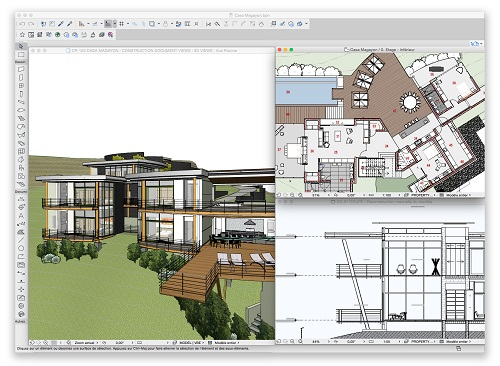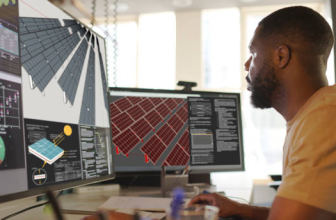The Evolution and Essentials of 3D Architecture Software

The architectural industry has seen a significant transformation with the advent of 3D architecture software. These cutting-edge solutions bring a new dimension to architectural design, making it more intuitive, precise, and appealing. With the use of 3D architecture software, architects can easily turn their abstract ideas into tangible models. From 3D architecture software that’s free for starters to advanced platforms for professionals, the available options can cater to various needs, enhancing efficiency, and offering flexibility.
Introduction to 3D Architecture
3D architecture is not a mere buzzword; it’s a revolutionary approach that has changed how architects design and visualize structures. It enables the creation of realistic 3D models that represent a building’s spatial and functional characteristics. This methodology is not limited to exteriors but can represent interiors in fine detail as well. This is a significant upgrade from traditional 2D drawings, bringing the design to life, offering a more interactive experience, and providing a more comprehensive understanding of the spatial relationships within the design.
The New Norm of 3D Architecture Software
3D architecture software has become an indispensable tool for architects and designers. It’s an essential part of the modern design process, aiding in visualizing, simulating, and analyzing complex architectural structures. As technology advances, so does the software’s capabilities, enabling architects to create more complex and intricate designs. These software platforms vary in functionality, pricing, and learning curve, making it crucial to choose the one that fits the specific requirements and helps in enhancing the creativity of the design process.
Free 3D Architecture Software: Getting Started
For those new to 3D architecture, several free software options can serve as an entry point into the world of 3D modeling architecture. Tools like SketchUp Free and Blender provide an excellent opportunity to explore and learn the basics without significant investment. These platforms may lack some of the advanced features of premium tools but are perfect for those just starting out. They offer essential functionalities and can be great for small projects or educational purposes, bridging the gap between novice and professional tools.
Professional 3D Architecture Software Solutions
For professionals, various advanced tools are designed to offer a comprehensive solution to their 3D architect needs. Some of the top ones include:
AutoCAD Architecture: A leading solution in the industry, AutoCAD Architecture offers a plethora of advanced features for detailed modeling and drafting. With its vast array of tools, it’s suitable for both residential and commercial projects.
Revit: This software is known for its Building Information Modeling (BIM) capabilities, allowing for intelligent 3D models that include construction information. It not only provides structural modeling but also integrates with various engineering disciplines.
ArchiCAD: Offering a user-friendly interface, ArchiCAD is known for its excellent performance and collaboration features. This platform is particularly known for its efficiency in design and documentation workflow.
3ds Max: Favored for visualization, 3ds Max offers powerful rendering capabilities for creating stunning visual presentations. It’s especially valuable for creating lifelike simulations and walkthroughs, providing clients with a tangible sense of the space.
Impact of 3D Architecture Modeling
3D modeling architecture has not only changed how architects design but also how they communicate their ideas. It allows for a more immersive experience, where clients can virtually walk through the design, understanding it in depth. The precision and realism of 3D models help in detecting potential flaws early in the design process. The benefits extend to improved visualization with architecture 3D modeling, making it easier to visualize the final product, enhancing decision-making, reducing errors, and creating a more cohesive and interactive collaboration between architects and clients.
Future Trends in 3D Architecture Software
The integration of technologies like Virtual Reality (VR) and Augmented Reality (AR) with 3D architecture software is already taking place. These advancements will further elevate the experience, making it more interactive and engaging. As the technologies mature, they are likely to become more accessible, enhancing the use of 3D architecture in various fields. The future trends show that we are just scratching the surface, and the full potential of these integrations still needs to be explored.
Conclusion
3D architecture software is transforming the architectural landscape, adding a new layer of depth, precision, and creativity to the process. From free options for beginners to robust professional tools, these platforms cater to various needs and skills, and the landscape is only expected to grow and diversify. The ability to create accurate and compelling representations of structures is paving the way for new architectural opportunities.
The impact of 3D modeling architecture is immense, influencing how designs are created, communicated, and executed. The future of architecture 3D modeling looks promising, with continuous innovations paving the way for even more sophisticated and intuitive solutions.
In a world where the demand for unique and functional architectural designs is ever-increasing, 3D architecture software stands as an essential tool, shaping the industry’s future, redefining how we think about architectural design, and offering unparalleled opportunities for innovation and expression. Whether you are an aspiring 3D architect or a seasoned professional, these tools are likely to be an integral part of your design journey, expanding the horizons of what can be achieved in the field of architecture.








